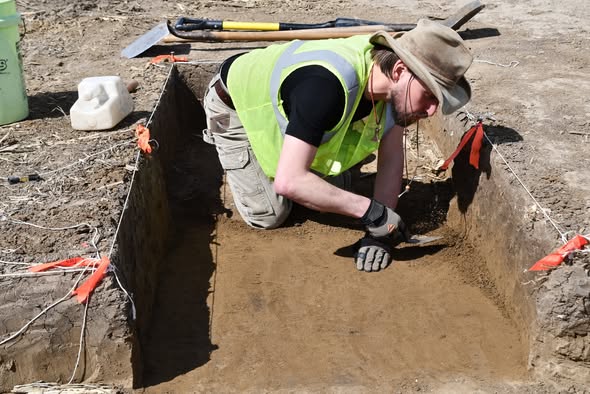Nebraska's Highway Archaeology Program
Beneath our highways lie remnants of historic Native American villages, fur trade posts, early homesteads, and military encampments—each revealing a chapter of Nebraska’s human story. Through the Highway Archaeology Program, part of the Nebraska State Historical Society's (NSHS) State Archeology Office (SAO), archaeologists partner with NDOT to to identify and protect these sites before roadwork begins.
The program operates under NDOT’s broader Highway Cultural Resources Program, which also coordinates paleontological preservation as part of the Highway Paleontology Program in collaboration with the University of Nebraska State Museum (UNSM). Established in 1960, these partnerships set the standard for highway-related scientific discovery and preservation—ensuring that Nebraska’s infrastructure development also contributes to our understanding of both ancient life and human history.
Early Efforts
NDOT’s commitment to preserving archaeological sites dates back nearly a century. Even before formal laws existed, district engineers and construction crews with an interest in history encouraged contractors to protect items of historical or geological significance found during construction. Early records note artifacts from Native American sites, pioneer settlements, and geological features being set aside or donated to local museums.
Legally, protection of fossils during highway construction began with the 1906 American Antiquities Act, and by the 1930s, NDOT highway specifications required contractors to report fossil finds. These early measures reflected a growing awareness that construction could uncover scientifically significant materials that deserved protection.
Concerns over impacts to Native American burials and Oregon Trail remnants during the planning of Interstate 80 in the 1950s led NDOT and NSHS to create the Nebraska Highway Archaeology Program (NHAP) in 1959 - one of the nation's first. That same year, the Nebraska Legislature passed a law authorizing NDOT to recover and preserve archaeological, paleontological, and historical materials discovered during highway projects (Nebraska Revised Statute 39-1363).
NDOT’s early state-level program later became a model for compliance with Section 106 of the National Historic Preservation Act (NHPA) of 1966, which added federal requirements for projects using federal funds. NDOT’s Highway Cultural Resources Program adapted its procedures to comply with these requirements.
The Program Today
Today, NDOT plans projects years in advance to avoid or mitigate impacts on archaeological sites. Over nearly six decades, NSHS archaeologists and historic architects have identified hundreds of sites, dozens of which have become the focus of major field investigations and research projects. The program also provides public outreach, volunteer opportunities, and hands-on experience for University of Nebraska–Lincoln archaeology students.
Archaeologists have documented sites from Pawnee and Omaha villages, Civil War-era homesteads, fur trade settlements, and even the remains of Major Stephen Long’s 1819–1820 scientific expedition—the first U.S. exploration of the Great Plains. Employing field surveys, aerial photography, and excavation techniques, archaeologists work years ahead of construction to prevent disturbance. When sites cannot be avoided, NDOT’s Highway Cultural Resources Program and SAO document and recover artifacts for study and preservation.
In the past decade, the Highway Cultural Resources Program and the SAO has evaluated more than 1,000 highway projects, identified over 200 previously unrecorded archaeological sites, and documented hundreds of historic structures, including:
- Major Stephen Long’s 1819-1820 Scientific Expedition cantonment area in Washington County
- Fort Mitchell military site in Scotts Bluff County
- Pawnee community at Genoa, including food storage areas
- Portions of historic downtown Brownville
- An 1880s Lincoln pottery factory and Civil War-era homesteads
More than 100 historic bridges statewide have been found eligible for the National Register of Historic Places. When replacement is necessary, NDOT preserves, records, or relocates these structures. In rare cases where historic sites cannot be avoided, systematic excavations recover valuable scientific information—advancing our understanding of Great Plains cultures and contributing to Nebraska’s heritage tourism.
Some findings have been featured in museum exhibits, school programs, and public events. In 2002, NDOT received the Asa T. Hill Memorial Award for outstanding contribution to Nebraska archaeology (established in 1975 by the Nebraska State Historical Society Foundation to recognize significant achievements in archaeological research or interpretation).

Nebraska Archaeology
Archaeology vs. Archeology
You may notice we spell archaeology with an “ae.” Some Nebraska organizations, like the Nebraska State Archeology Office, drop the extra “a.” The difference goes back to when the U.S. Government Printing Office simplified spellings by removing the “ae” ligature, leading agencies to adopt archeology. Most universities and museums, including UNL, kept the traditional archaeology spelling, while some government and cultural resource groups use archeology.
Why Archaeology Matters?
Archaeology reveals the 98% of Nebraska’s human history that came before written records — helping us understand how people lived, worked, and built communities.
How Long Have People Live in Nebraska?
For at least 13,500 years, as shown by Clovis spear points — the state’s oldest known artifacts.
Who Lived Here?
Tribes with historic ties to Nebraska include the Pawnee, Omaha, Ponca, Otoe-Missouria, Santee, and Lakota, among others. Later, military settlers, fur traders, immigrants, and farmers also shaped Nebraska’s early communities.
Hidden Treasures
Only a small number of artifacts ever go on display, but the thousands stored in museums are invaluable to understanding the past. Researchers and students study collections to uncover new details about Nebraska’s past. Although thousands of sites have been found, archaeologists have explored less than 10% of Nebraska’s land.
